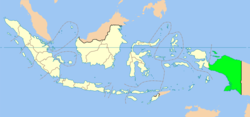In early push into Papua, palm oil firms set stage for massive forest plunder
by Hans Nicholas Jong
- Large-scale deforestation and a high number of hotspots indicate that the arrival of the oil palm industry in Indonesia’s Papua region is wreaking the same kind of destruction wrought on forests in Sumatra and Kalimantan.
- A new report calls the scale of the problem alarming, with the potential for even greater losses as only a small fraction of the forests issued for oil palm plantations has been cleared.
- The palm oil industry’s push into the region, after nearly depleting forests in Sumatra and Kalimantan, has been helped by government programs to boost investment in Papua.
The clearing of Indonesia’s last untouched swath of pristine forest has begun in earnest, with an area the size of Washington, D.C., razed for just a single oil palm plantation in Papua province, new data show.
Nearly 200 square kilometers (77 square miles) of forest have been cleared in Merauke district since 2014 for the plantation, according to the Washington-based World Resources Institute (WRI), with 10 square kilometers (3.9 square miles) being opened up just since October.
Arief Wijaya, senior manager for climate and forests at the Jakarta office of the WRI, said the scope of the deforestation was alarming. Cutting down that many trees for a single plantation area, he said, “emits 11 million tons of CO2, equivalent to the emission of 2.1 million cars in a year.”
In neighboring Boven Digoel district, at least 37 square kilometers (14 square miles) of primary forest has been cleared for another plantation. This represents less than a tenth of the total concession awarded to plantation firm PT Megakarya Jaya Raya in 2012, pointing to deforestation on an even greater scale to come.
“Although the loss is considered ‘planned’ deforestation and legal, clearing such a large expanse of natural forest can permanently damage the ecosystem and ultimately reduce its economic productivity,” the WRI said.
New frontier
The extent of this early round of deforestation spells trouble for Papua and West Papua provinces, which together make up the Indonesian half of the island of New Guinea and account for 35 percent of the country’s remaining rainforest, spanning 294,000 square kilometers (113,500 square miles).
The government and businesses have in recent years eyed the country’s easternmost provinces as a new frontier ripe for plantations, primarily oil palm, which have already nearly depleted the forests of Sumatra and Kalimantan, the Indonesian part of Borneo.
There were 59,000 square kilometers (22,780 square miles) of oil palm plantations in Sumatra in 2015, and 50,000 square kilometers (19,300 square miles) in Kalimantan, according to a recent study by Duke University and the International Institute for Applied Systems Analysis. Together, they account for 96 percent of oil palm plantations in the country. The Papua region had just 2,000 square kilometers (113,500 square miles), or 2 percent.
The remoteness of the region, lack of infrastructure and a low-level armed insurgency kept many businesses out of Papua and West Papua for decades. But in recent years the government has sought to prioritize the economic development of the region, including by handing out concessions for plantations in the country’s last remaining stretches of virgin forest.
Starting fires
In Boven Digoel district alone, about 200 square kilometers is earmarked for five palm oil companies.
But that pales in comparison to Merauke, where 12,000 square kilometers (4,630 square miles), a quarter of the district’s total area, has been allotted for the government’s Merauke Integrated Food and Energy Estate (MIFEE) program. Already the program has drawn criticism, with activists blaming it for more than 11,000 hotspots detected there as a result of fires set deliberately to clear vegetation — a common practice in the palm oil industry in Sumatra and Kalimantan.
Only two of the 10 proposed blocks in the MIFEE are supposed to include palm oil, but Greenpeace has noted that “significantly” more oil palm concessions are to be included.
Among the companies with concessions in Merauke is Korindo, a South Korean-Indonesian joint venture that is also the largest palm oil company in Papua. A 2016 report by the environmental group Mighty and its partners blames it for 300 square kilometers (116 square miles) of deforestation and nearly 900 fire hotspots since 2013.
In 2012, companies submitted investment applications for a combined 15,000 square kilometers (5,800 square miles) of plantations there, and preliminary proposals for another 20,000 square kilometers (7,720 square miles).
The amount of deforestation driven by oil palm expansion in the region has increased fivefold to 710 square kilometers (274 square miles) in the 2010-2015 period from the 1995-2000 period, according to the Duke University study.
“The proportion of new plantations replacing forests is also substantially larger than in Sumatra and Kalimantan, and increased over the study period, reaching a high of 66 percent from 2010 to 2015,” the study found.
Starting fires
In Boven Digoel district alone, about 200 square kilometers is earmarked for five palm oil companies.
But that pales in comparison to Merauke, where 12,000 square kilometers (4,630 square miles), a quarter of the district’s total area, has been allotted for the government’s Merauke Integrated Food and Energy Estate (MIFEE) program. Already the program has drawn criticism, with activists blaming it for more than 11,000 hotspots detected there as a result of fires set deliberately to clear vegetation — a common practice in the palm oil industry in Sumatra and Kalimantan.
Only two of the 10 proposed blocks in the MIFEE are supposed to include palm oil, but Greenpeace has noted that “significantly” more oil palm concessions are to be included.
Among the companies with concessions in Merauke is Korindo, a South Korean-Indonesian joint venture that is also the largest palm oil company in Papua. A 2016 report by the environmental group Mighty and its partners blames it for 300 square kilometers (116 square miles) of deforestation and nearly 900 fire hotspots since 2013.












